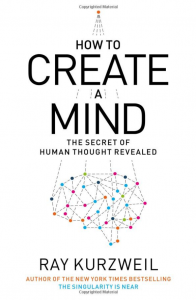How to Create a Mind: The Secret of Human Thought Revealed – Book Review
 Ever since I read “Singularity is Near” I’ve been fascinated by Ray Kurzweil – his wirings, ideas, a predictions. He’s not been afraid to go on the limb and make some brave and seemingly outlandish forecasts about the upcoming technological advances and their oversize impact on people and society. One of the main reasons why I always found his predictions credible is that they can, in a nutshell, be reduced to just a couple of seemingly simple observations: 1. Information-technological advances are happening exponentially, and 2. Information technology in particular is driving all the other technological and societal changes. The rest, to put it rather crudely, are the details.
Ever since I read “Singularity is Near” I’ve been fascinated by Ray Kurzweil – his wirings, ideas, a predictions. He’s not been afraid to go on the limb and make some brave and seemingly outlandish forecasts about the upcoming technological advances and their oversize impact on people and society. One of the main reasons why I always found his predictions credible is that they can, in a nutshell, be reduced to just a couple of seemingly simple observations: 1. Information-technological advances are happening exponentially, and 2. Information technology in particular is driving all the other technological and societal changes. The rest, to put it rather crudely, are the details.
In “How to Create a Mind” Kurzweil zeroes in on just one scientific/technological project – creating a functioning replica of the human mind. He uses certain insights from information technology and neurology to propose his own idea of what human mind (and by extension human intelligence) are all about, and to propose how to go about emulating it “in silico.” Here too Kurzweil reduces a seemingly intractable problem that the humanity has grappled with for millennia to just a couple of overarching insights. In his view the essence of virtually all cognitive processes can be reduced to the scientific paradigm of “pattern recognition” – an ability of computational agent to identify and classify patterns. And the information theoretical and engineering tool for emulating the kind of pattern recognition that goes on in a mind is the mathematical technique called “hierarchical hidden Markov chains” (HHMS). What gives Kurzweil confidence about this insight and this kind of approach are the successes that he has had in starting and marketing companies which used HHMS for speech and character recognition. Many of these technologies and their derivatives have in recent years made it to the wide ranging set of consumer products (Apple’s Siri is just one such example), so it’s not surprising that Kurzweil would be feeling exceptionally confident about his insights. However, the history of computation and artificial intelligence is filled with examples of paradigms that seemed promising at one level of “thinking” complexity only to be proven ineffective at tacking more sophisticated problems. Furthermore, even though I am not an expert at neuroscience, Kurzweil’s descriptions of what goes on in an actual biological brain come across as not too sophisticated. He is obviously well informed on many neurobiological topics, far above what even a well-educated reader may know, but from what I know about biology the intricacies of the brain are still too complex to be reduced to a simple (simplistic?) model. Kurzweil may still turn out to be right about what he is proposing in this book (and if I had to bet I would loath to bet against him), but the evidence that he presents leaves a lot of potential gaps and pitfalls that would need a lot more convincing to completely bridge.
This is definitely a very well written book with a lot of interesting and though-provoking insights and predictions. Anyone interested in scientific and technological progress in the upcoming years and decades would greatly benefit from reading it, especially since it’s such an enjoyable book. I highly recommend it.

I appreciate reading your overview on How to Create a Mind, Bojan. I’ve enjoyed the concepts of this scientific futurist for quite some time. Thank you, Susan Winter